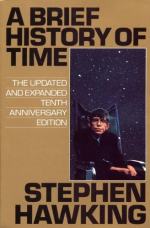
|
| Name: _________________________ | Period: ___________________ |
This test consists of 15 multiple choice questions and 5 short answer questions.
Multiple Choice Questions
1. Who published a paper on Brownian motion in 1905?
(a) Ernest Rutherford.
(b) Albert Einstein.
(c) James Chadwick.
(d) Murray Gell-Mann.
2. Scientists start their understanding of the universe with what?
(a) Mathematics.
(b) Observations and mathematics.
(c) Observations.
(d) A theory.
3. Which virtual particle carries the electromagnetic force?
(a) Magnetron.
(b) Proton.
(c) Photon.
(d) Electron.
4. What type of theories try to bring the various virtual particles together as one entity, but do not include gravity?
(a) Grand Unification Theories.
(b) Grand Complete Theories.
(c) Theories of Everything.
(d) Theories of Unification Principles.
5. Who wrote the introduction?
(a) Max Planck.
(b) Carl Sagan.
(c) Edwin Hubble.
(d) Stephen Hawking.
6. In what year did Wolfgang Pauli bring the exclusion principle to physics?
(a) 1941.
(b) 1932.
(c) 1928.
(d) 1925.
7. Black holes are similar to the singularity that existed before what event?
(a) The big bang.
(b) The destruction of cluster galaxies.
(c) The creation of the earth.
(d) The expansion of the universe.
8. The theory of quantum mechanics best describes what world?
(a) The small world of molecules.
(b) The small world of atoms.
(c) The small world of sub-atomic particles.
(d) The small world of particles.
9. In the universe, objects move in what type of direction?
(a) In straight lines.
(b) In circular motions.
(c) In waves.
(d) In curved lines.
10. The idea of the big bang arises from what phenomena?
(a) The expanding universe.
(b) The theory of relativity.
(c) The decreasing universe.
(d) The theory of light.
11. What is the name of the particles that make up light?
(a) Photons.
(b) Protons.
(c) Gluons.
(d) Electrons.
12. What force is so strong in a black hole that nothing can escape?
(a) Gravity.
(b) Electricity.
(c) Force.
(d) Magnetism.
13. A black hole results from a large star using up what type of fuel?
(a) Helium.
(b) Gaseous.
(c) Hydrogen.
(d) Liquid.
14. Who brought forth the idea that the earth and planets revolve around the sun?
(a) Galileo.
(b) Aristotle.
(c) Copernicus.
(d) Ptolemy.
15. In what year did Stephen Hawking enter the Royal Society of London?
(a) 1972.
(b) 1975.
(c) 1973.
(d) 1974.
Short Answer Questions
1. What theory best describes the singularities of black holes and big bangs?
2. How does Hawking define scientific theory?
3. Who said, "God does not play dice."
4. Time is not separate from space, but is combined with it to form what?
5. Aristotle thought that the Earth was what?
|
This section contains 412 words (approx. 2 pages at 300 words per page) |

|




